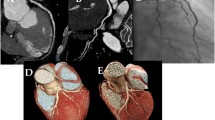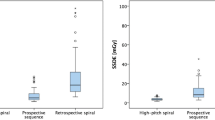Abstract
Background
Coronary computed tomography angiography (CTA) is increasingly used as a test to rule out coronary artery disease (CAD) in patients with a low to intermediate pre-test probability of the disease. We used the database of the German CT registry, collected between 2009 and 2014 in a broad patient population, to analyze contemporary radiation dose associated with coronary CTA in clinical practice.
Patients and methods
The prospective observational registry included a total of 7061 patients ≥18 years, referred to 12 participating centers for a clinically indicated cardiac CT examination. All centers were cardiology units well experienced in CTA and used multi-slice CT scanners with at least 64 rows. Coronary CTA was performed in a subset of 5001 patients, 59.6 ± 11.8 years, body mass index (BMI) 26.9 ± 4.5 kg/m2, 38% females. Three time periods with approximately equal numbers of patients were created (01/09–03/10, 04/10–03/11, 04/11–07/14). The dose–length product of all examinations and derived effective dose in mSv (conversion factor k = 0.014) as well as the influence of patient characteristics on dose were compared for the three time periods.
Results
BMI and proportion of female patients remained stable over time, and mean heart rate decreased from 60.3 ± 9.0 to 58.5 ± 9.3 bpm from the first to the last time period (p < 0.001). Overall, the mean effective dose of coronary CTA was 3.6 mSv (Q1 1.8 mSv, Q3 7.4 mSv). Within the three time periods, it declined from 5.6 (2.7, 8.6) mSv during the first to 4.8 (2.1, 8.2) mSv during the second and 2.5 (1.3, 4.6) mSv during the last time period (p < 0.001). Paralleling the decline in radiation dose over time, the proportion of prospectively ECG-triggered examinations increased (68, 79, 83%; p < 0.001), and the proportion of examinations with retrospective gating and no tube current modulation decreased (5.3, 4.0, 1.6%; p < 0.001). Tube current (mAs) and voltage (kV) both decreased over time. In multivariable analysis, besides earlier time period, further independent predictors of an increased radiation dose were older age, higher heart rate, and higher BMI as well as the technical factors higher mAs, higher kV, and retrospective gating. At three sites, CT scanners with improved technology were installed during the last time period.
Conclusions
In current clinical practice among German cardiology units with specific expertise in cross-sectional cardiovascular imaging, overall radiation dose of coronary CTA was comparably low. Over time, a decline in radiation dose was demonstrated, probably due to a combination of improvements in data acquisition protocols and patient preparation as well as installation of new CT scanners with advanced technology.


Similar content being viewed by others
References
Montalescot G, Sechtem U, Achenbach S et al (2013) 2013 ESC guidelines on the management of stable coronary artery disease: the Task Force on the management of stable coronary artery disease of the European Society of Cardiology. Eur Heart J 34:2949–3003 (erratum in: Eur Heart J 2014;35:2260–2261)
Einstein AJ, Moser KW, Thompson RC, Cerqueira MD, Henzlova MJ (2007) Radiation dose to patients from cardiac imaging. Circulation 116:1290–1305
Einstein AJ, Henzlova MJ, Rajagopalan S (2007) Estimating risk of cancer associated with radiation exposure from 64-slice computed tomography coronary angiography. JAMA 298:317–323
Gerber TC, Carr JJ, Arai AE et al (2009) Ionizing radiation in cardiac imaging. science advisory from the American Heart Association Committee on Cardiac Imaging of the Council on Clinical Cardiology and Committee on Cardiovascular Imaging and Intervention of the Council on Cardiovascular Radiology and Intervention. Circulation 119:1056–1065
Hausleiter J, Meyer T, Hermann F et al (2009) Estimated radiation dose associated with cardiac CT angiography. JAMA 301:500–507
Hunold P, Voigt FM, Schmermund A et al (2003) Radiation exposure during cardiac CT: effective doses at multi-detector row CT and electron-beam CT. Radiology 226:145–152
Perrin M, Djaballah W, Moulin F et al (2015) Stress-first protocol for myocardial perfusion SPECT imaging with semiconductor cameras: high diagnostic performances with significant reduction in patient radiation doses. Eur J Nucl Med Mol Imaging 42:1004–1011
Hell MM, Bittner D, Schuhbäck A et al (2014) Prospectively ECG-triggered high-pitch coronary angiography with third-generation dual-source CT at 70 kVp tube voltage: feasibility, image quality, radiation dose, and effect of iterative reconstruction. J Cardiovasc Comput Tomogr 8:418–425
Bongartz G, Golding SJ, Jurik AG et al (2004) European guidelines for multislice computed tomography. Funded by the European Commission. Contract number FIGM-CT2000-20078-CT-TIP, March 2004. http://www.msct.eu/CT_Quality_Criteria.htm. Accessed 19 Oct 2016
SCOT-HEART investigators (2015) CT coronary angiography in patients with suspected angina due to coronary heart disease (SCOT-HEART): an open-label, parallel-group, multicentre trial. Lancet 385:2383–2391 (erratum in: Lancet 2015;385:2354)
Husmann L, Herzog BA, Burger IA et al (2010) Usefulness of additional coronary calcium scoring in low-dose CT coronary angiography with prospective ECG-triggering impact on total effective radiation dose and diagnostic accuracy. Acad Radiol 17:201–206
Marwan M, Mettin C, Pflederer T et al (2013) Very low-dose coronary artery calcium scanning with high-pitch spiral acquisition mode: comparison between 120-kV and 100-kV tube voltage protocols. J Cardiovasc Comput Tomogr 7:32–38
Poll LW, Cohnen M, Brachten S, Ewen K, Mödder U (2002) Dose reduction in multi-slice CT of the heart by use of ECG-controlled tube current modulation (“ECG pulsing”): phantom measurements. Rofo 174:1500–1505
Gerber TC, Stratmann BP, Kuzo RS, Kantor B, Morin RL (2005) Effect of acquisition technique on radiation dose and image quality in multidetector row computed tomography coronary angiography with submillimeter collimation. Invest Radiol 40:556–563
Gopal A, Mao SS, Karlsberg D et al (2009) Radiation reduction with prospective ECG-triggering acquisition using 64-multidetector computed tomographic angiography. Int J Cardiovasc Imaging 25:405–416
Arnoldi E, Johnson TR, Rist C et al (2009) Adequate image quality with reduced radiation dose in prospectively triggered coronary CTA compared with retrospective techniques. Eur Radiol 19:2147–2155
European Commission In: De Cort M, Tollefsen T, Marsano A, Gitzinger C (eds) EUR 23950—environmental radioactivity in the european community 2004–2006. Office for Official Publications of the European Communities 2009, Luxembourg. https://rem.jrc.ec.europa.eu/RemWeb/Reports.aspx, Accessed 23 Oct 2016
Erbel R, Budoff M (2012) Improvement of cardiovascular risk prediction using coronary imaging: subclinical atherosclerosis, the memory of lifetime risk factor exposure. Eur Heart J 33:1201–1213
Löwel H, Meisinger C, Heier M, Hörmann A, von Scheidt W (2005) Herzinfarkt und koronare Sterblichkeit in Süddeutschland. Deutsches Ärzteblatt 103:A616–A622
Piepoli MF, Hoes AW, Agewall S et al (2016) 2016 European guidelines on cardiovascular disease prevention in clinical practice: the sixth joint task force of the European Society of Cardiology and Other Societies on Cardiovascular Disease Prevention in clinical practice (constituted by representatives of 10 societies and by invited experts). Developed with the special contribution of the European Association for Cardiovascular Prevention & Rehabilitation (EACPR). Eur Heart J 37:2315–2381
Opolski MP, Kim WK, Liebetrau C et al (2015) Diagnostic accuracy of computed tomography angiography for the detection of coronary artery disease in patients referred for transcatheter aortic valve implantation. Clin Res Cardiol 104:471–480
Acknowledgements
Funding was provided by Stiftung Institut für Herzinfarktforschung, Ludwigshafen.
Author information
Authors and Affiliations
Corresponding author
Ethics declarations
Conflict of interest
Axel Schmermund, Mohamed Marwan, and Stephan Achenbach have received speaker honoraria from Siemens Healthineers Deutschland, manufacturer of cardiac CT machines.
Appendix
Appendix
Centers participating in the German cardiac CT registry in alphabetical order:
-
Cardioangiologisches Centrum Bethanien, Frankfurt,
-
Deutsches Herzzentrum, Munich,
-
Elisabeth Krankenhaus Essen,
-
Herzzentrum Bogenhausen, Munich,
-
Kerckhoff Klinik, Bad Nauheim,
-
Klinikum am Eichert, Göppingen,
-
Klinikum Ludwigshafen,
-
Klinikum Traunstein,
-
Universitätsklinikum Erlangen,
-
Universitätsklinikum Gießen,
-
Universitätsklinikum Heidelberg,
-
Universitätsklinikum Tübingen.
Rights and permissions
About this article
Cite this article
Schmermund, A., Marwan, M., Hausleiter, J. et al. Declining radiation dose of coronary computed tomography angiography: German cardiac CT registry experience 2009–2014. Clin Res Cardiol 106, 905–912 (2017). https://doi.org/10.1007/s00392-017-1136-8
Received:
Accepted:
Published:
Issue Date:
DOI: https://doi.org/10.1007/s00392-017-1136-8




